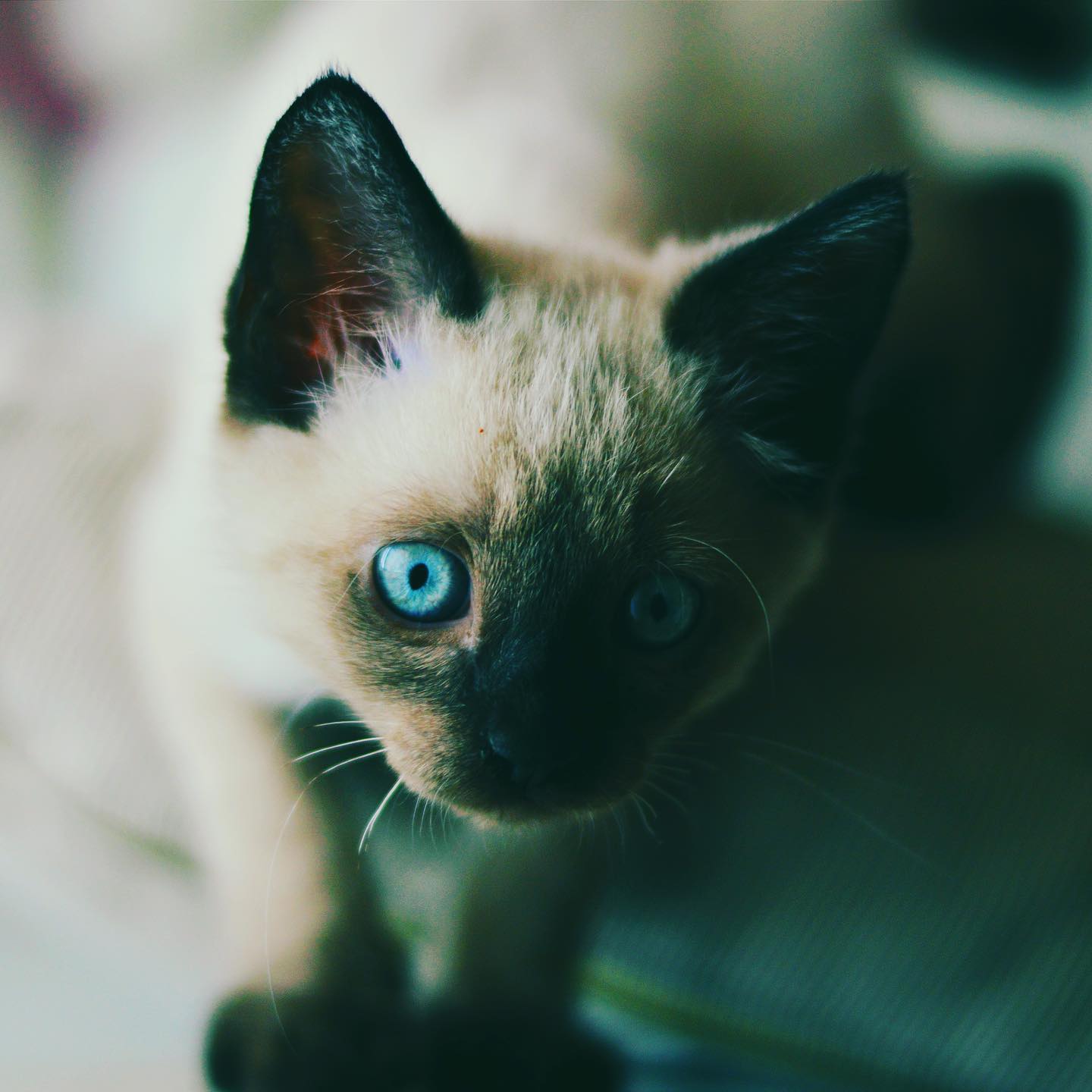Can Cats Eat Pepperoni? As a dedicated cat parent, I remember the first time my curious feline friend gazed longingly at a slice of pepperoni pizza. Those big eyes seemed to plead, “Can I have just a tiny bite?” But understanding whether cats can eat pepperoni requires more than just falling for those adorable expressions.
When it comes to pepperoni and cats, the answer isn’t as simple as a yes or no. Is pepperoni safe for cats? The short answer is no. Pepperoni contains high levels of sodium, fat, and preservatives that can potentially harm your furry companion’s health.
Cat owners often wonder about sharing human foods with their pets. While it might seem harmless to offer a small piece of pepperoni, the risks outweigh any momentary pleasure. The high fat content – approximately 46% in pepperoni – can contribute to obesity, a serious health concern for cats.
Understanding what you can and cannot feed your cat is crucial. Pepperoni and cats simply don’t mix well. The processed meat’s ingredients can cause digestive issues, potential allergic reactions, and long-term health problems that no pet owner wants to face.
This article will dive deep into why pepperoni isn’t a safe treat for your feline friend and provide you with essential information to keep your cat healthy and happy.
Table of Contents
Understanding Your Cat’s Diet
Cats are special animals with their own food needs. They are meat-eaters and need the right mix of nutrients to stay healthy.
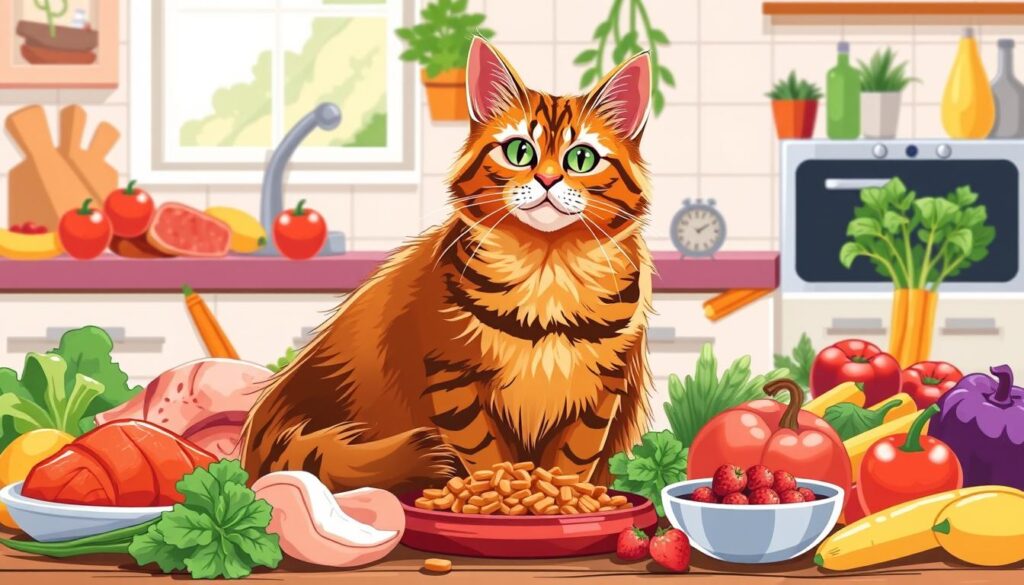
Feeding pepperoni to cats is not a good idea. Cats and pepperoni don’t mix well in terms of food.
Importance of a Balanced Diet
A balanced diet is key for cats. It gives them the nutrients they need to live well. Cats need certain foods to stay healthy:
- High-quality animal protein
- Essential fatty acids
- Specific vitamins and minerals
- Taurine (an amino acid critical for heart and eye health)
What Do Cats Need Nutritionally?
Cats have specific nutritional needs. Giving them pepperoni can upset this balance. Here’s what they really need:
| Nutrient | Percentage/Requirement | Purpose |
|---|---|---|
| Protein | 24-35% of daily calories | Muscle maintenance and development |
| Fat | 15-20% of diet | Energy and cellular function |
| Taurine | Essential amino acid | Heart and eye health |
Common Cat Food Ingredients
When talking about pepperoni and cats, it’s important to know about cat food. Good cat food has:
- Chicken
- Fish
- Turkey
- Beef
- Organ meats
“Cats are not small dogs or tiny humans. Their nutritional needs are unique and must be respected.” – Veterinary Nutritionist
Knowing what your cat needs can help avoid health problems. Giving them pepperoni is not a good choice.
The Nutritional Profile of Pepperoni
Exploring pepperoni and cat diet is key. It’s important to know the nutritional makeup of pepperoni. Cats have special dietary needs, making pepperoni a risky choice.

Key Ingredients in Pepperoni
Pepperoni has ingredients that can harm cats. The main parts are:
- Processed meat (pork and beef)
- High sodium content
- Preservatives like nitrates
- Various spices
Caloric Content of Pepperoni
Pepperoni’s caloric density is crucial for cat health. A 10-gram serving has over 50 calories. This is a lot for cats.
| Nutritional Component | Percentage | Impact on Cat Health |
|---|---|---|
| Protein | 19% | Low nutritional value |
| Fat | 46% | High risk of obesity |
| Sodium | 35% | Potential kidney strain |
Protein and Fat Levels
When thinking about cats and pepperoni, protein and fat are key. Cats need 70-80% animal-based protein. But pepperoni doesn’t meet these standards.
“Just because cats are carnivores doesn’t mean all meat products are safe for them.” – Veterinary Nutrition Expert
The fat in pepperoni is a big health risk. With over 46% fat, it can cause weight gain and obesity. Obesity affects about 50% of cats in the U.S.
Potential Risks of Feeding Pepperoni to Cats
Feeding pepperoni to cats can be very risky. Cats and pepperoni digestion don’t go well together. This processed meat is not safe for your feline friend.
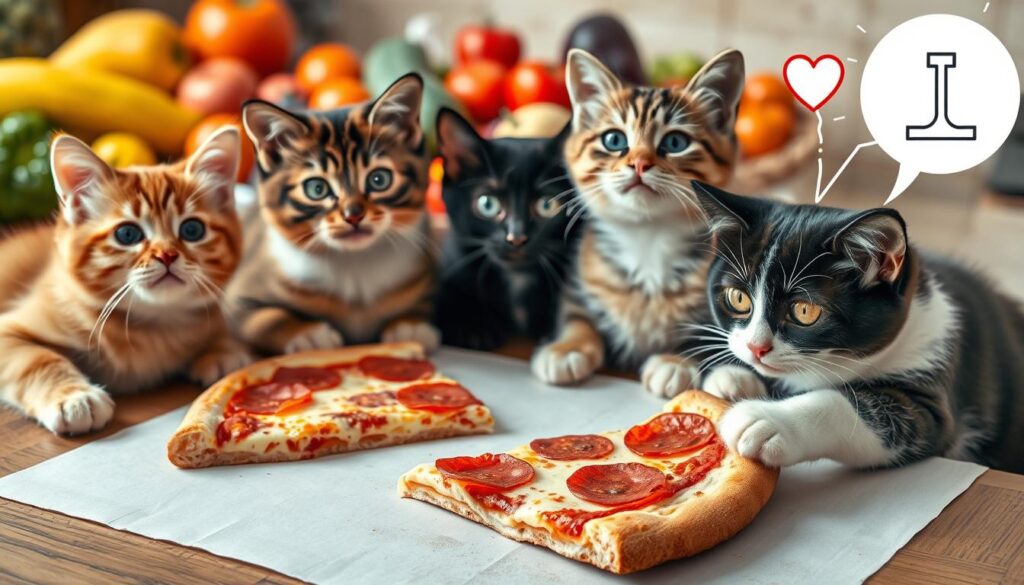
Cats have very sensitive stomachs. They can’t handle the ingredients in pepperoni. The fat in pepperoni can harm their health in many ways.
Health Concerns Associated with Processed Meats
Processed meats like pepperoni can cause health issues in cats. Studies show that up to 30% of cats may have digestive problems after eating high-fat foods. The dangers include:
- Increased risk of pancreatitis
- Potential digestive tract inflammation
- Potential weight gain and obesity
High Sodium Content Issues
Pepperoni is not safe for cats. It has too much sodium. Cats can’t handle sodium well, which can cause serious health problems.
| Sodium Risk Factor | Potential Health Impact |
|---|---|
| Excessive Sodium Intake | Hypertension in 30-50% of older cats |
| Salt Poisoning Symptoms | Lethargy, extreme thirst, tremors |
| Potential Complications | Kidney stress, cardiovascular issues |
Allergies and Sensitivities
Pepperoni also has ingredients that can cause allergic reactions in cats. Garlic and spices can destroy red blood cells and lead to anemia.
“Prevention is always better than cure when it comes to your cat’s diet.” – Veterinary Nutrition Expert
Vets advise against giving pepperoni to cats. Your cat’s health is better off with a diet that meets their specific needs.
Alternatives to Pepperoni for Treats
When thinking about treats for your cat, it’s important to look beyond pepperoni. Cats need special food that’s more than just processed meat. Choosing safe, healthy options can keep your pet happy and healthy.

Healthier Meat Options for Cats
While pepperoni is not safe for cats, there are better meat choices:
- Cooked, unseasoned chicken breast
- Plain turkey without added spices
- Lean, boiled fish like salmon or tuna
- Small portions of cooked lean beef
“Cats are obligate carnivores, requiring high-quality animal proteins for optimal health.” – Veterinary Nutrition Experts
Safe Vegetables and Fruits
Some fruits and veggies can be treats for cats, but only in small amounts:
- Small cucumber pieces
- Tiny blueberry segments
- Steamed pumpkin
- Cooked carrots (in moderation)
Commercial Cat Treats to Consider
For easy options, many commercial cat treats are a good choice:
- Protein-rich freeze-dried meat treats
- Veterinarian-approved dental chews
- Low-calorie training treats
- Grain-free options with natural ingredients
Always talk to your vet before adding new foods to your cat’s diet. This ensures they’re safe and nutritious.
Signs of Distress After Eating Pepperoni
Understanding the signs of distress after eating pepperoni is key for cat owners. Cats can eat pepperoni, but it might not be good for them.
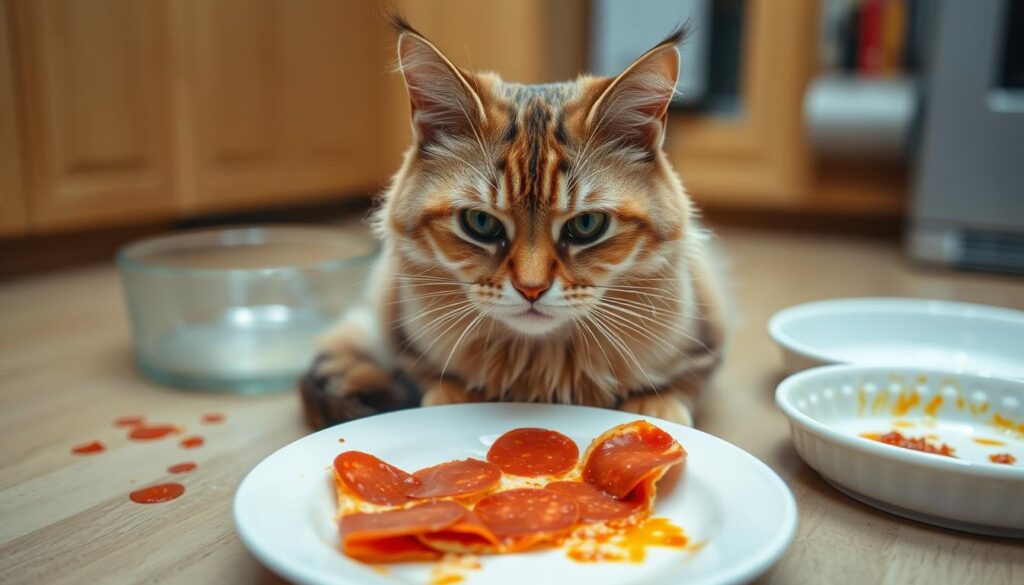
Spotting early signs of distress can help avoid serious health issues in your cat.
Gastrointestinal Warning Signs
- Vomiting within hours of eating pepperoni
- Persistent diarrhea or loose stools
- Sudden loss of appetite
- Visible signs of abdominal discomfort
Potential Allergic Reactions
Pepperoni can cause allergic reactions in cats. Look out for:
- Skin irritations or unexpected itching
- Respiratory difficulties
- Excessive grooming
- Unexplained hair loss
When to Seek Veterinary Care
Get your cat to the vet if they show:
“Persistent symptoms can indicate serious underlying health issues related to dietary indiscretion.”
- Continuous vomiting lasting more than 24 hours
- Signs of dehydration
- Lethargy lasting more than a few hours
- Blood in stool or vomit
While cats can have pepperoni sometimes, the risks are often too high. Choose vet-approved treats that are good for your cat’s health.
How Often Can You Treat Your Cat?
When it comes to treating your cat, you need to think carefully. Cats enjoy treats, but not all are good for them. Especially with pepperoni and cats digestion, you must be very careful.
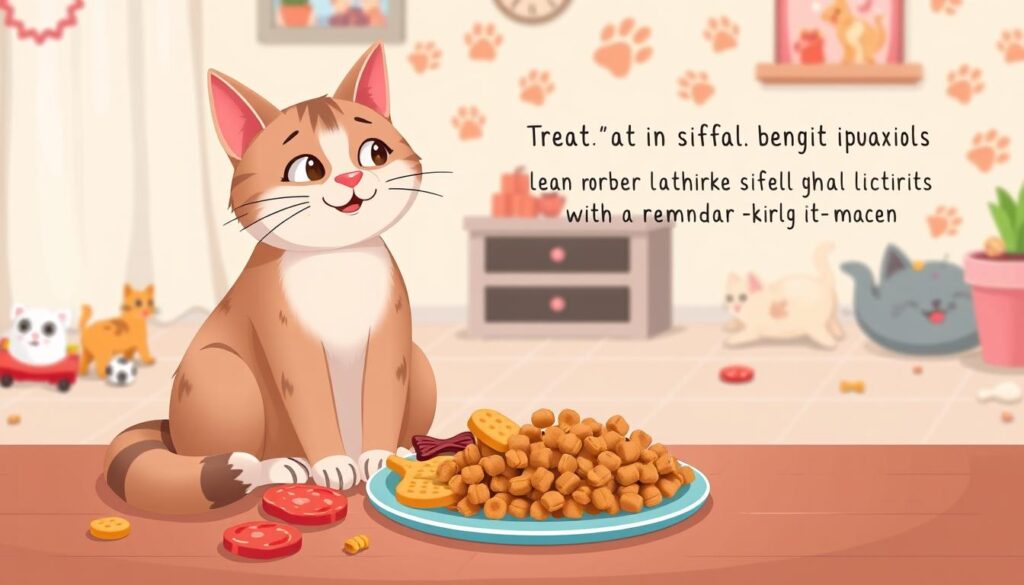
Moderation: The Golden Rule of Cat Treats
Treats should not make up more than 10% of your cat’s daily food. Pepperoni is not safe for cats. It can actually harm their health.
- Limit treats to small portions
- Choose cat-specific treats
- Avoid high-sodium human foods
- Prioritize nutritional value
Guidelines for Treating Cats
When picking treats for your cat, look for quality and nutrition. No, cats should not eat pepperoni. It’s too fatty, salty, and has bad additives.
| Good Treats | Bad Treats |
|---|---|
| Lean protein pieces | Processed meats |
| Commercial cat treats | High-sodium snacks |
| Small meat portions | Fatty human foods |
Recognizing Good Treats vs. Bad Treats
It’s important to know the difference between healthy and bad treats. Cats are obligate carnivores and need certain nutrients. Pepperoni is bad for cats because of its fat and potential digestive problems.
“The best treats for cats support their health, not compromise it.” – Veterinary Nutrition Experts
Always talk to your vet about the right treats for your cat. They can help based on your cat’s diet and health.
How to Introduce New Foods to Your Cat
Introducing new foods to your cat needs careful thought, especially with pepperoni. Cats have special dietary needs that are different from ours. Knowing how to introduce new foods can keep your cat healthy and happy.
Vets advise extreme caution when giving pepperoni to cats. Cats are sensitive and need specific nutrients that pepperoni can’t provide.
Gradual Introduction Techniques
Here’s a step-by-step plan to introduce new foods:
- Start with tiny amounts
- Mix new foods with their regular food
- Watch how your cat reacts
- Wait 24-48 hours before giving more
Monitoring Reactions to New Foods
“Prevention is better than cure when it comes to your cat’s diet.” – Veterinary Nutrition Expert
Be alert for these signs when introducing pepperoni to your cat:
| Reaction Type | Symptoms to Observe | Action Required |
|---|---|---|
| Digestive Distress | Vomiting, Diarrhea | Stop feeding, contact veterinarian |
| Allergic Response | Skin Irritation, Excessive Scratching | Immediate veterinary consultation |
| Behavioral Changes | Lethargy, Decreased Appetite | Monitor closely, seek professional advice |
Keeping Records of Your Cat’s Diet
Keeping a food journal is key. It tracks your cat’s diet and any reactions. Write down everything: date, food, amount, and any changes in behavior or health.
- Use a notebook or app
- Record time and amount of new food
- Document any physical or behavioral changes
- Share with your vet
Remember, pepperoni is not good for cats. Always choose healthy, balanced treats for your cat’s diet.
Understanding Cat Behavior Around Food
Cats have unique behaviors around food. Their food choices are based on instinct, smell, and nutrition. Knowing why cats like certain foods helps manage their diet and avoid health risks.
Why Cats May Crave Human Food
There are several reasons why cats like human food, especially pepperoni:
- Strong sense of smell that attracts them to fatty, aromatic foods
- Curiosity about new food textures and flavors
- Learned behavior from watching human eating patterns
Cats are natural hunters with an innate desire to explore different food sources, which can sometimes lead them to inappropriate dietary choices.
The Role of Smell in Cat Food Preferences
A cat’s sense of smell is incredibly strong. Cats have about 200 million odor sensors, compared to humans’ 5 million. This makes them very attracted to foods with strong smells, like pepperoni.
| Smell Factor | Cat’s Response |
|---|---|
| High Fat Content | Increased Interest |
| Strong Meat Aroma | Immediate Attraction |
| Processed Meat Smell | Potential Craving |
How to Train Your Cat to Avoid Certain Foods
Training your cat to stay away from pepperoni and other bad foods takes time and effort:
- Use positive reinforcement techniques
- Provide engaging alternative treats
- Keep human food out of reach
- Establish a consistent feeding routine
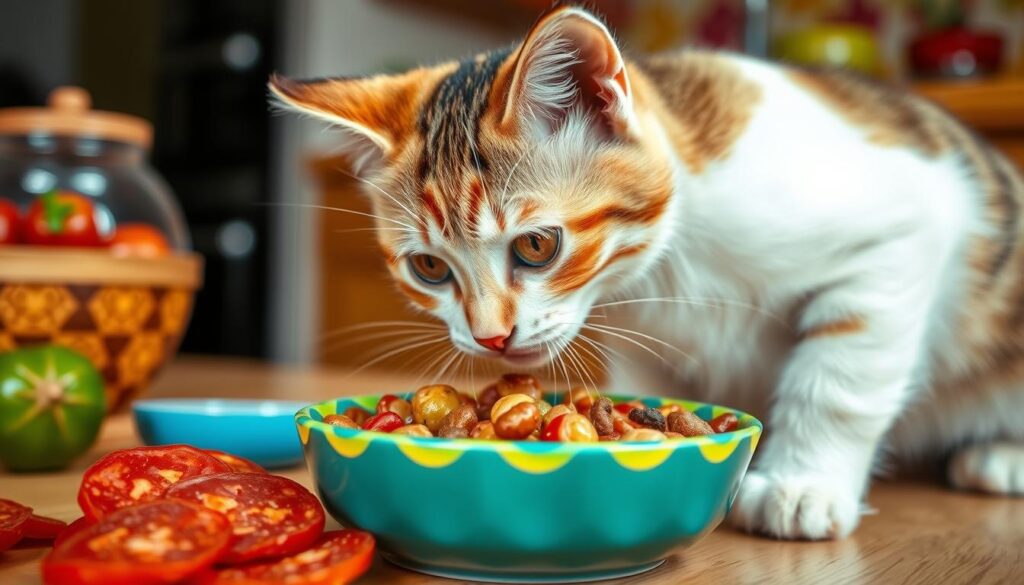
While cats might be curious about pepperoni, their diet should always come first. Always talk to your vet about the best food for your cat’s health.
Homemade Cat Treat Recipes
Making treats for your cat is a great way to avoid processed snacks like pepperoni. Pepperoni isn’t good for cats, but homemade treats can be a healthier choice. They let your cat enjoy tasty food without harming their health.
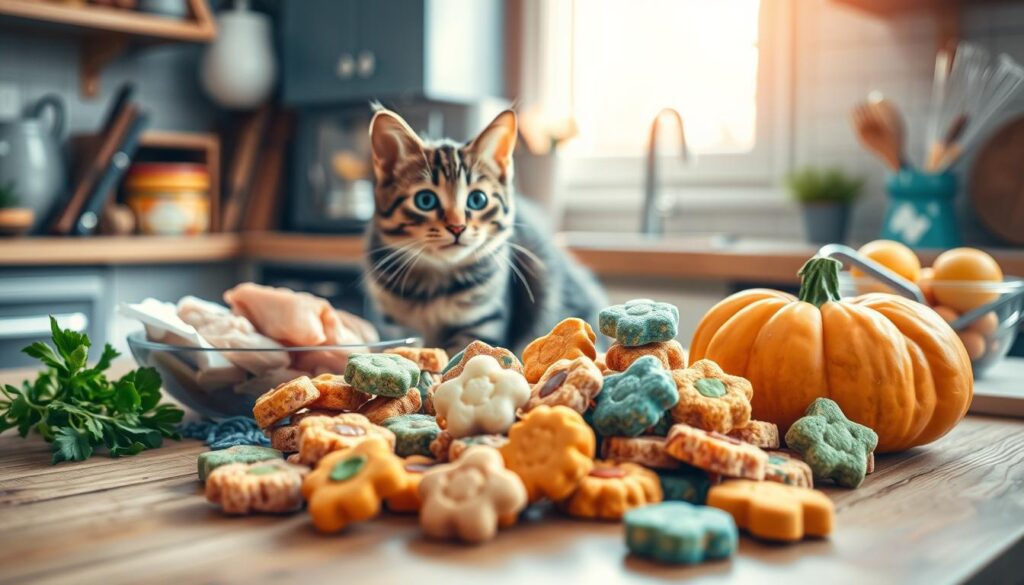
Pepperoni is not safe for cats. Instead, make tasty homemade treats that are good for your cat’s health.
Easy Homemade Meat Treats
Cats need certain foods because they are meat-eaters. Here are some easy meat treat ideas:
- Baked chicken strips (unseasoned)
- Freeze-dried fish pieces
- Small cubes of cooked turkey
- Dehydrated salmon treats
DIY Healthy Cat Snacks
When making treats, remember these tips:
- Choose lean, high-quality proteins
- Don’t add salt or seasonings
- Make treats small and control portions
- Try to match treats with your cat’s regular food
“The best treats are those that provide nutritional value while keeping your cat excited and satisfied.” – Veterinary Nutrition Expert
Avoiding Common Ingredients That Are Unsafe
When making treats, avoid these harmful ingredients:
- Onions
- Garlic
- Chocolate
- Grapes
- Raisins
Pro tip: Always check with your vet before trying new homemade treats. Make sure they’re right for your cat’s needs.
While cats might like pepperoni, it’s not safe. It has too much salt and fat, which can be very bad for them. Homemade treats are a safer, healthier choice for your cat.
Conclusion: Is Pepperoni Safe for Cats?
After looking closely at pepperoni and cats, we find that pepperoni is not safe for cats. Cats need a special diet that is different from what humans eat.
Key Takeaways for Cat Owners
Feeding pepperoni to cats can be harmful. It has too much salt, spices, and processed stuff. These can hurt your cat’s health.
- Pepperoni has too much salt, which can cause dehydration.
- Spices in pepperoni can upset your cat’s stomach.
- The fat in pepperoni can lead to pancreatitis.
- Pepperoni can cause allergic reactions in cats.
Final Recommendations
When picking treats for your cats, choose safe and healthy options. Pepperoni is not good for your cat’s diet.
| Food Type | Safety for Cats | Recommended Alternative |
|---|---|---|
| Pepperoni | Unsafe | Lean, plain meat treats |
| Commercial Cat Treats | Safe | Veterinarian-approved options |
“Your cat’s health is always more important than a momentary treat.” – Veterinary Nutrition Experts
Talk to your vet about what food is best for your cat. Cats should eat mostly animal protein. Choose foods that are right for them.
Additional Resources for Cat Owners
Understanding cat nutrition can be tricky, especially when it comes to foods like pepperoni. Professional vets and research centers offer great advice. They help you choose the right food for your cat.
The American Veterinary Medical Association (AVMA) has lots of info on pet nutrition. They talk about safe and unsafe foods. Websites like Cornell Feline Health Center also have detailed info on pepperoni and cat diets. They help you see the dangers of processed meats for cats.
Trusted Websites for Cat Nutrition
Websites like PetMD and VCA Animal Hospitals have a lot of nutritional info. They explain how foods like pepperoni can affect your cat’s health. But remember, every cat is different, and their needs can vary.
Recommended Books on Pet Health
Books like “Cat Sense” by John Bradshaw and “The Cat: Clinical Medicine and Management” by Susan Little are great. They give scientific insights into cat nutrition. They help you make better choices for your cat’s diet and health.
Vet Resources for Cat Owners
Your local vet is the best for personalized nutrition advice. Many vet clinics offer nutrition counseling. They help you create a diet plan that meets your cat’s health needs and avoids bad food choices.

